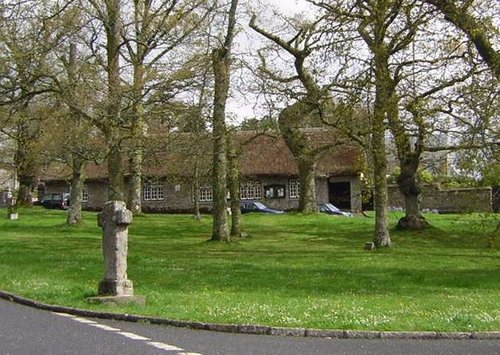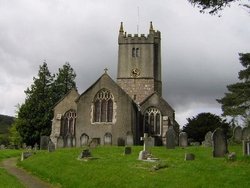Please login or click here to join.
Forgot Password? Click Here to reset pasword

Nestled in the side of a hill on the edge of Dartmoor, in the 1960s this little village used to boast a school, a village hall, public house, post office, two stores and a church, all set around the perimeter of a road that circled the green.
In those days the only time the grass was cut was the night before the annual village fair, held during the month of July. On Bovey Fair Day, long trestle tables covered in starched cloths were placed at intervals around the green, displaying the results of hours of effort spent in village kitchens or gardens.
You could run a race, bowl for a pig, toss a sheaf, take a pony ride or watch the tug-of-war, while in the village hall a flower and vegetable show would be taking place. I have to chuckle here, as I can recall what my dear old dad used to say about what one of my uncles used to put on his cabbages to make them grow!
In the center of the green stood a stone trough and pump with an iron handle. It would creak and groan, but faithfully draw water. On the day of the village fair this trough was transformed into a rather magical place--the Lucky Dip. Filled with sawdust and parcels wrapped in crepe paper, children were drawn to it like magnets. I know I always spent a long time trying to decide which parcel to choose for my three-penny piece.
The village fair ended with a square dance and the hall would be packed to capacity. People of all ages would be there; great-grandmas to babies. When I wasn't dancing myself, I marveled at the way the floor moved up and down with the exuberance of the lusty Devon lads 'do-si-doing' and 'swinging their partners to the right', and wondered that it didn't collapse. The band would be just one man, Bob Cann he was called--famous from Cornwall through Somerset for his accomplishment of the accordion. He was so popular with the villagers they would hire no one else for the famous Bovey Fair Dance.
 Our house was one of a row of granite and brick-built cottages. From our front windows, which faced south, you could see the church. The gold clock face was set on the east side of the granite tower, so there was never an excuse for not knowing the time--or going to church for that matter.
Our house was one of a row of granite and brick-built cottages. From our front windows, which faced south, you could see the church. The gold clock face was set on the east side of the granite tower, so there was never an excuse for not knowing the time--or going to church for that matter.
We had a front lawn flanked by flowerbeds, a stone wall on one side and a wooden fence on the other. The wall had a sloping top where my parents had once set seashells in cement. As a small child I spent many an hour sitting on that wall, trying to pry those shells off (and no doubt being scolded for it!)
Beyond our front garden was a shop situated in the front room of someone's cottage. They sold woolens, linens and haberdashery. Further down the road was the general store. When I was sent to fetch a quarter pound of ham I would follow the storekeeper into the back of the shop and watch, like the ravenous little creature I was, every slice of ham as it fell neatly from the cutting machine onto a piece of wax paper. I could barely contain my hunger pangs and always hoped he would offer me just one crumb of that ham. He never did and I'd disappointedly trail after him into the main store, my stomach rumbling, my mouth drooling. I can still remember the smell of that delicious ham; I never taste anything as delicious these days.
On the south side of the village green was the bus stop and we had a bus service provided twice daily by the Devon General Bus Company. That was before vehicles became popular. In those days you could ramble around the lanes all day and never see one.
The village post office was in the first of a group of four cottages, just around the corner from the bus stop. The postal room was gloomy and smelled rather damp. You went down into it on large, flagstone steps. I can remember the postmistress as being a near-sighted lady who wore her hair in an untidy bun. From my child's eye, her teeth appeared to me to be black and gold, and she wore small, round gold-rimmed glasses.
By far the most popular place in the village was the Ring of Bells, which was known for miles around for its delectable food and hospitality. I found my first employment there as a waitress and took great pride in earning pocket money and tips from serving cream teas. I must have been all of twelve years old. Whenever I could I'd cadge rides on the ponies, as they kept stables where people could rent horses by the hour. One of the sons used to ride point-to-point, and one of their horses, Tarky Town, became quite well known. Once I exercised a racehorse for one whole winter season. Fairy Sprite was her name. The inn used to 'donate' a pony to the fair, for pony rides. You may guess who the first taker was.
Overlooking the village green was the elementary school, run by two teachers. Many children attended that little school, some traveling from the village of Manaton and the outlying farms, in an old battered bus that had a driver who always forgot to shave.
Then as the years passed, once North Bovey was 'discovered', it began to change. As the elderly people passed on, the cottages were bought by wealthy people who came from the towns and cities. They either bought the properties as an investment or for holiday homes. Local people, needing work, moved nearer the towns. They could no longer afford the inflated prices.
With the new people came their cars, and the Devon General bus service was first cut then finally discontinued. The haberdashery shop owner retired and closed her store. The post mistress died, and the post office was transferred to the general store. But the storekeeper found that the weekend people brought their own groceries and he stopped selling many lines of food. This in turn lost trade, and eventually he also closed.
The children that once filled the crowded school bus grew up and moved away, many by necessity and others enticed by the opportunities in the towns and cities. Things changed quickly in just a few years. By the time those who stayed behind had their own children the village school had been sold and became a private residence.
The newcomers took over the village council. Some of the trees on the village green were felled; others trimmed. The green itself became manicured; new seed sown over the paths. The pump handle was chained down so that 'children could no longer annoy the villagers by playing with it'.
I witnessed my childhood home, my North Bovey, change completely. Outwardly it remains charming and would no doubt retain its title of one of the prettiest villages in England. But the last time I visited it in 2004, remembering the vibrant, thriving place it once was, I found it was only an echo of its past.
Celia, an author born and reared in Devon, moved to Canada several years ago but still has poignant memories of her childhood home. She includes these in her Dartmoor Series novels which begin with Mary's Child, the first in a trilogy. PastPresent I: Web of Lies was released by Twilight Times Books, Tennessee, in 2008 and Celia is currently working on the third and final novel: PastPresent II: Time Returned. Celia's books are available as print books or electronic books, and information can be found on her website at https://www.devonshirebabe.com/.
© 2009 Celia Ann Leaman
| Article Title | Author | Date |
| The Prettiest Streets in England | poe | 24th November 2020 |
| 10 of the best villages to visit in the Peak District, England | poe | 28th July 2020 |
| A look at some of the most famous views in England... | poe | 16th May 2020 |
| THE TRIAL OF THE PYX | Paul V. A. Johnson | 19th August 2019 |
| The Best Sandy Beaches in Dorset | poe | 7th June 2016 |
| 20 Of The Best Market Towns In England | poe | 1st June 2016 |
| A Human Heart and a Ghost Story in a Northamptonshire Church | Charles Moorhen | 30th October 2009 |
| Exploring the English Village Churchyard | Charles Moorhen | 29th October 2009 |
| Local Legends - The Basingstoke Burial | poe | 28th February 2008 |
| The Hidden Churches of Somerset | Louise Simmons | 6th February 2008 |